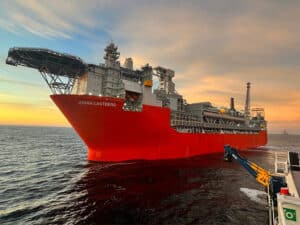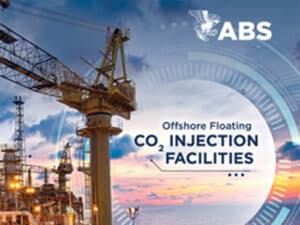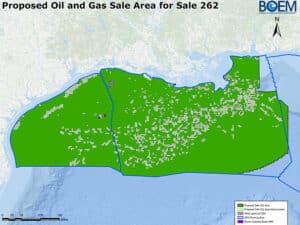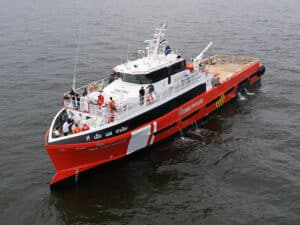
CSV is designed for maximum operational availability
Written by Nick Blenkey AUGUST 28, 2012 — Responding to market demands for offshore construction support vessels (CSVs) for deep and harsh environments, Norway’s GC Rieber Shipping has placed a NOK 800 million order with Ulstein for a high-capacity subsea vessel based on its SX121 design. The order includes an option for a second ship.
AUGUST 28, 2012 — Responding to market demands for offshore construction support vessels (CSVs) for deep and harsh environments, Norway’s GC Rieber Shipping has placed a NOK 800 million order with Ulstein for a high-capacity subsea vessel based on its SX121 design. The order includes an option for a second ship.
The 130-m long, 25-m wide vessel can accommodate a crew of 130 and has a top speed of 14.5 knots, while meeting all the latest environmental standards. She is equipped with a powerful 250 ton AHC (active heave compensated) offshore crane, for lifting and lowering heavy equipment to and from subsea environments.
A large cargo deck creates the optimal environment for a variety of operations, ensuring that the vessel is well placed to meet the very diverse demands of the offshore construction market. It also offers the ability to carry two ROVs (remotely operated vehicles) – one launched from the starboard side and the other through a moon pool.
In addition, the ship has been designed with SURF (subsea umbilical riser and flowline) capabilities and is prepared for the installation of a below-deck basket/ carousel with a 2500 ton capacity, as well as a 250 ton VLS (vertical lay system) for deployment through the moon pool.
“One of the main reasons for choosing the SX121 design from Ulstein was its inherent flexibility, which allows several types of operations and enables us to operate in a wider range of market segments,” says Bjørn Valberg, GC Rieber Shipping’s Technical Director. “The fact that we can utilize the 250 ton crane to the maximum of its capability both in offshore and subsea lifts on this vessel was another deciding factor.”
Alongside state-of-the-art features, equipment and performance figures, the vessel will give GC Rieber Shipping maximum operational availability. Downtime will be minimized thanks to the “operation+” feature, an evolution of GC Rieber Shipping’s own “fail-to-safe” design approach.
“Operation+” allows the vessel to continue to operate even if it has experienced a significant failure.
“Fail-to-safe means that even if a ship encounters a failure it is rendered in a safe condition. Our objective with this ship is to take that philosophy a step further,” says Mr. Valberg.
“In the case of this vessel,” he says, “a single failure – such as a failure of a generator set, a single thruster or even an entire switchboard section (operating two generators and two thrusters) – will not threaten the redundant continuation of operations, giving charterers real peace of mind.”
Mr. Valberg illustrates this with a real-life scenario involving subsea flex pipe laying – an operation the new vessel is optimized for – where, if a single failure was encountered, a “standard” ship would be forced to terminate operations as redundancy would be jeopardized.
“If you are in deep waters with a substantial length of product, such as flex pipe, hanging from the ship, abandoning that operation is [quite obviously] difficult, time-consuming and expensive,” says Mr. Valberg.
“This new vessel, thanks to ‘operation+’ is protected against that scenario – it could continue with its assignment,” he says. “That’s a hugely important characteristic of that vessel, helping the charterer meet the demanding expectations of the market.”
Ulstein’s design and solutions team has been working to turn this concept into reality.
Geir Sivertstøl, principal engineer electrical systems at Ulstein, says the vessel, equipped with three main thrusters and three side thrusters (for stationkeeping during pipe laying), is fully optimized for carrying out assignments without interruption.
“The switchboard system, propellers and diesel motors can be configured in groups of two, three or four,” says Mr. Sivertstøl. “In case of an AUTR operation (i.e. the occurrence of a single major failure), the vessel will only lose one third of its installed power package and propulsion, and will be able to complete the operation with two thirds of its capacity.”
“This,” he stresses, “in combination with the highest standards for dynamic positioning, DYNPOS-AUTRO, will ensure that charterers can look forward to operational standards that are custom made to tackle the world’s harshest – and potentially most resource rich – environments.”
GC Rieber Shipping’s vessel is, according to Tore Ulstein, deputy CEO in Ulstein Group, the “perfect project” for Ulstein to show its design and shipbuilding pedigree. Tore Ulstein notes that Ulstein is well accustomed to developing and producing vessels that have the capability to minimize operational downtime, maximizing customers’ profits.
He commented: “Our organization has broad expertise in developing advanced high-capacity offshore vessels together with customers, so this project suits us perfectly.”
The SX121 is scheduled for delivery from the shipyard in the first quarter of 2014, boosting GC Rieber Shipping’s fleet (which was fully booked at the conclusion of 2011) of 18 advanced special purpose vessels, 12 of which are owned by the company.





Leave a Reply
You must be logged in to post a comment.